SPECIAL NOTE: HANDMADE CUSTOM WEDDING AND ENGAGEMENT RINGS ARE OUR SPECIALTY. Our artisan jewelers can make the ring of your dreams, backed by a lifetime guarantee. Call our shop at 888-733-5238 or email info (at) reflectivejewelry.com for a free consultation. —Marc Choyt, co-owner
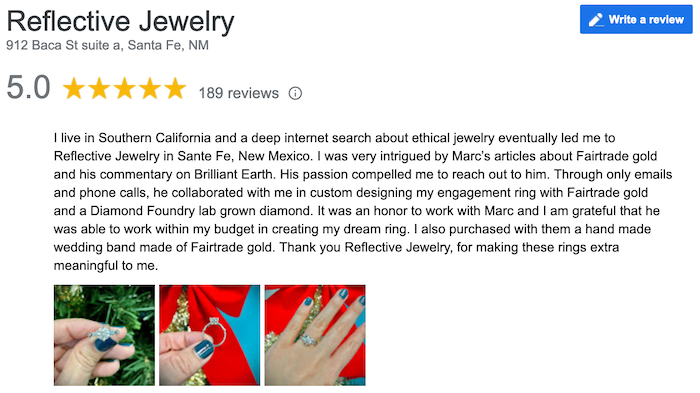
If you’re looking to have you and/or your partner’s wedding rings made from naturally white metals, gold wedding rings—which much be alloyed in order to be made white—are not an option. Other than silver, the decision comes down to either platinum or palladium.
Yet, finding the key differences between platinum wedding rings and palladium wedding rings from a source you can trust is not easy. We've been jewelers for 25 years. Check out our Google reviews.
Let me cut to the chase:
Because of changes over the last few years, particularly in context to how metal prices, one choice is clearly better. You’ll learn why in this article, which provides 9 key points allowing you to compare the benefits and drawbacks between these two naturally white metals.
Let’s start with a bit of history to provide some context to later points about the physical properties of platinum and palladium wedding rings.
1. History of Platinum and Palladium In Jewelry Production
Both platinum and palladium are considered among the rarest of metals in the earth's crust. Historically, palladium was discovered recently in the early 1800s, while platinum was used by pre-Columbian Indigenous people in Central America, who made artifacts out of a platinum and gold compound. In Europe, platinum was first written about in the 1500s.
Palladium was first used in jewelry in 1939 to alloy platinum. Palladium is actually more rare than platinum and is found only in a few mines around the world. Though palladium has been used in jewelry production for decades, palladium wedding bands have become particularly popular over the past fifteen years.
In fact, since January 2010, palladium has been officially recognized as a precious metal. Any palladium wedding ring more than a gram in weight is legally required to be hallmarked.
Both metals are part of what is considered the "platinum group", a collection of naturally white metals that also include osmium, rhodium, iridium, and radium.
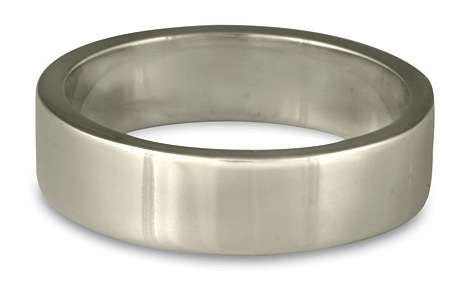
This Comfort Fit wedding band is made from recycled platinum.
2. Comparative Weight of Platinum and Palladium Rings
Of all the naturally white metals, platinum is the densest (heaviest) of all the metals while palladium is the least dense (lightest) of them. Consequently, palladium wedding rings will feel considerably lighter than platinum wedding rings if held in your hand.
Once you get the ring on your finger, however, it’s not likely you’ll notice the differences between the two metals. Over time, the ring will just come to feel a natural part of your body.
This is not to say that palladium is particularly light. For example, the weight of palladium wedding rings is comparable to a 14K Gold wedding rings, while platinum is about 75% heavier than 14K Gold.
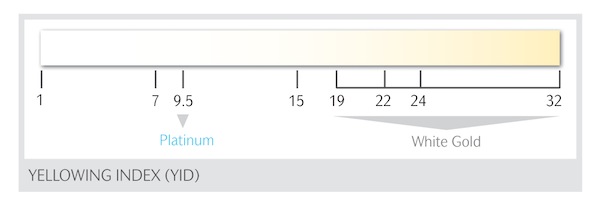
This graph displays the various degrees of yellow in wedding rings and other jewelry alike.
3. Color Comparison Between Platinum and Palladium Wedding Rings
Both platinum wedding bands and palladium wedding bands are comparable in whiteness. Most people viewing a platinum wedding ring next to a palladium wedding ring would have difficulty telling the difference.
These days, whiteness is determined by a color spectrophotometer developed by Albert Munsell, which is shown above.
Unlike white gold, which can vary according to the alloys used in the ring, palladium and platinum are pure natural white metals.
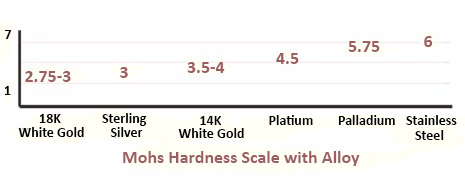
This graph shows the various hardness degrees of metals commonly used in wedding rings.
4. Hardness of Palladium and Platinum Wedding Rings
In terms of hardness, as shown above in the graph, both platinum and palladium are hard metals—even harder than 14K Gold wedding rings.
On the Mohs scale, platinum is rated at a 4 and palladium a 5. However, when alloyed, platinum goes up to a 4.5 and palladium to a 5.75.
Just to give you some context as to what these numbers mean, the bottom of the scale (a “1”) is talc, and at the top (a “10”) is diamond.
Your finger nail would rate at 2.5, the same hardness as pure gold or pure silver.
The difference in hardness between and platinum and palladium wedding band is not significant in context to wearing over your lifetime. Both are tried and true choices.
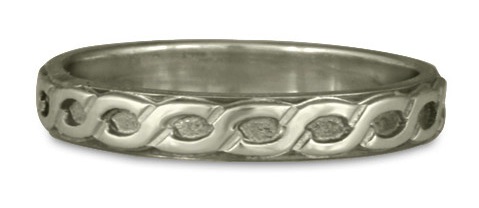
This Borderless Rope Wedding Ring, shown in Platinum, was handmade in our Santa Fe studio.
5. Alloys In Platinum and Palladium Rings
However, these numbers in regard to hardness are only general estimates, because alloy plays a role in hardness. How a particular precious metal is alloyed can be highly technical and proprietary.
Both platinum wedding rings and palladium wedding rings generally have 5% alloy. In the case of palladium, ruthenium is often used for 4.8% of the alloy, with trace amounts of copper or other components added in order to ease casting and fabrication. Platinum wedding rings are alloyed with iridium, rhodium, and ruthenium.
Additionally, noble white qualities and relative affordability of palladium has made it one of the most popular alloys for white gold wedding rings, particularly for those who prefer a nickel-free white gold.
6. Wear and Tarnishing of Platinum and Palladium Wedding Rings
Both platinum wedding bands and palladium wedding bands will scratch, though palladium is about 10% more scratch resistant. Jewelers cleverly called the minute surface scratches a patina, Latin for "shallow dish.”
When scratched, palladium and platinum tend to "furrow" rather than chip. While many people prefer the patina, because the rings appear to have a matte finish, others prefer a mirror finish. The metal can simply be put back in place on a nonabrasive polishing wheel. The ring will look as shiny as when it came out of its box.
Both platinum and palladium are considered "noble metals" because they are naturally superior in their ability to withstand oxidation and corrosion.
Also, neither will tarnish, both are hypoallergenic and both will remain white forever.
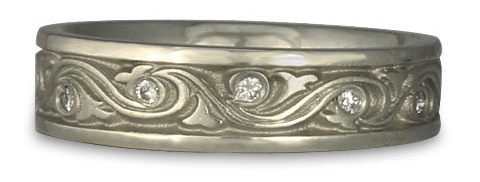
Our Wind and Waves Wedding Ring is shown here in Platinum and adorned with diamonds.
[ If you’ve gotten this far into our article, why not just contact us about your project? There’s no charge for consultation, and I’ll give you a price quote. Give me a call at 888-733-5238, or email info (at) reflectivejewelry.com ]
7. Pricing of Platinum and Palladium Wedding Rings
Platinum wedding rings have been, for many years, the preferred and more popular choice for those wanting white-metal wedding ring.
Platinum has been the most expensive metal used in jewelry and therefore, has more status and brand caché.
For many years, more and more couples chose palladium. At that time, the choice came down to price. At that time, palladium wedding bands typically ran about half the cost of platinum bands. They were simply more affordable.
Since 2014, however, palladium has jumped in price in the $850 range to above $2000 an ounce. Meanwhile, platinum has had just the opposite trend—falling from around $1500 to the $1000 range.
Platinum is still more expensive than gold because of its weight, but palladium rings are comparable or even more expansive to platinum.
Once on the finger, there is really little difference between how the two metals appear.
Based upon the comparison, given platinum’s status and appeal as a white metal, and the fact that palladium is the same price, the clear choice between a platinum and palladium wedding ring is platinum.
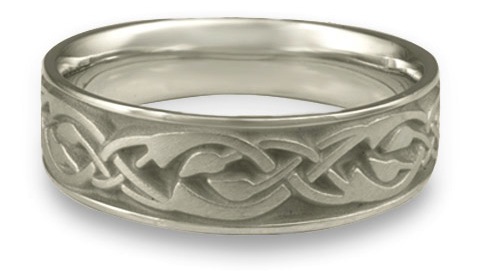
Platinum wedding rings have a stunning crisp snow white color that makes for a gorgeous ring. Pictured here, our Narrow Tulips and Vines Wedding Ring.
Bonus Points!
*Since we first created this article, we've expanded it a little!
Continue on for more info on Palladium vs Platinum wedding rings...
8. Fabrication of Platinum and Palladium Wedding Rings
Both metals are fabricated using molds that can be created by hand carving wax or through computer-generated models on jewelry CAD/CAM programs. Unlike gold and silver, which can be molded and shaped by hand, both platinum and palladium are relatively brittle.
They are more difficult to work with by hand and, outside of stone setting, they are typically cast out or dye struck.
Anything that can be made into platinum can also be made into palladium, or gold for that matter.
9. Ethics of Palladium and Platinum Wedding Rings
The most ethical wedding and engagement ring are made from certified Fairtrade precious metals. Several years ago, Fairtrade eco-platinum was coming out of the Ore Verde mine in Colombia, but that mine has closed down. Only very small amounts of platinum are being processed as byproducts from Fairtrade Gold mining, and this material is not available.
One option for those who cares about mining issues is to purchase a palladium or platinum wedding ring made of recycled metal. But in context to ethical sourcing, this option doesn’t really make much of a difference. Using recycled metals does not mitigate the terrible damage from mining that occurs at present. Learn more about why that is here.
Marc Choyt is president of Reflective Jewelry, a designer jewelry company founded in 1995. He pioneered the ethical sourcing movement in North America and is also the only certified Fairtrade Gold jeweler in the United States. Choyt’s company was named Santa Fe New Mexico’s Green Business of the Year in 2019, and he has been honored with several awards for his efforts to support ethical jewelry. His ebook, Ethical Jewelry Exposé: Lies, Damn Lies and Conflict Free Diamonds, is available online. Choyt can be reached on Twitter at @Circlemanifesto or by email at marc(at)reflectivejewelry.com.